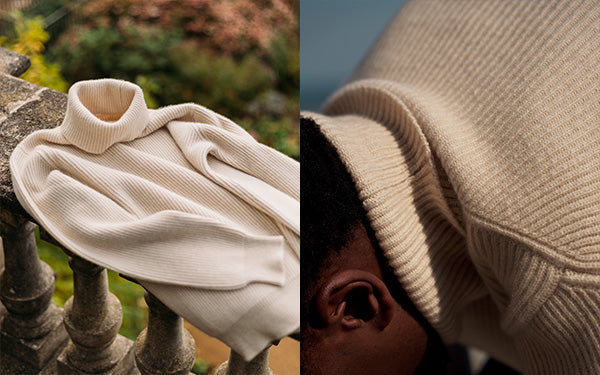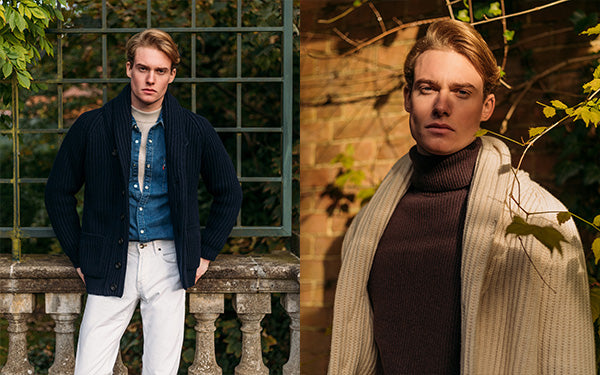
The backbone of our knitwear: the world's highest quality fibres
Quality fibres are crucial if you want to create a quality piece of knitwear. At Colhay’s we only source yarns from world renowned spinners, and presently, we are working with Todd and Duncan, Cariaggi Lanificio and Zegna Baruffa. Each yarn spinner has their own specialty – something that they are exceptionally good at, head and shoulders above the rest, and that is why we have chosen to work with Todd & Duncan for our cashmere and superfine lambswool, Cariaggi for our cashmere silk and Zegna Baruffa for our extrafine merino. Todd and Duncan, Cariaggi and Zegna Baruffa supply luxury brands across the globe and are known for their exceptional attention to detail and rigorous testing when sourcing their fibres. To create high quality yarns you first need high quality fibres, so these processes are vital.
It goes without saying that everything we produce is made entirely of natural fibres. This makes them far more environmentally friendly and better for the wearer’s skin. We are increasingly seeing manmade fibres appearing in knitwear. Unlike those made with natural fibres, which are biodegradable, garments made of manmade fibres can’t quickly break down when they’re disposed of. They will be in landfill for decades before decomposing properly. As well as being environmentally friendly and more likely to last a long time, natural fibres are breathable and much more comfortable for the wearer.
However, choosing to use natural fibres is just the start. To create a truly high quality piece of knitwear – an heirloom piece that lasts a lifetime, and can be passed down generations, one must use the very best of the natural fibres, and there is a hierarchy.
Not only do we insist on using only natural fibres, we also insist on using only the very best of each type of natural fibre.
Below we’ve outlined the four fibres we use to create our knitwear with, with more details on why we’ve chosen them given their different qualities, and why they are the very best in the hierarchy of that particular fibre.
Cashmere
Cashmere is a rare and sought-after fibre. It’s produced from the undercoat of specific breeds of goat in inner Mongolia. It’s a lightweight material and is incredibly soft to the touch.
Soft and light isn’t all this fibre can do. It has some practical qualities too. Despite being lightweight, cashmere is incredibly warm – just as warm, if not warmer than the chunkiest of lambswool sweaters, without the very heavy weight. This is what makes it such a desirable material to use, and also why it is highly priced. It’s perfect if you want to create a garment that keeps the wearer cosy but not feeling weighed down or bundled up. The reason for this is that it’s a natural fibre whose primary function is to keep the goats warm in the mountains. The goats yielded this fibre naturally in order to protect themselves from the harsh cold of higher altitudes. Being a natural fibre also means it’s breathable, so you won’t overheat either. It is temperature regulating. Some heat can dissipate so if your body is very warm, you won’t get any warmer and you’ll always be at a comfortable temperature.
Because of these qualities, the best garments to make cashmere in are the staples that you want to wear time and time again with any outfit. They don’t have to be heavily designed or fussy, hence why we have chosen cashmere to make crew necks, v necks, polo shirts, rollnecks and shirt cardigans, because we know these are the styles that will get lots of wear. See more here.
The demand for cashmere has exploded in recent years and in some areas the industry has struggled to keep up without detrimental effects to the planet. Large companies can put pressure on goat farmers to produce high yields at low cost and in a small area of land which cannot sustain a large amount of grazing goats. These small patches of land over time have gone from being lush and green to barren because of overgrazing by the large number of goats. For this reason, it started to develop a bad reputation over the past 10-15 years. The practice of pressurising cashmere farms to produce high quantities of cashmere led to poorer quality, and so whilst the amount of cashmere being produced has increased significantly, the quality has also simultaneously declined for a lot of cashmere products that are now being produced.
This can be avoided though, by doing thorough research and ensuring you source the cashmere from the highest ranked and most reputable yarn spinners who have a long history of cultivating the highest quality cashmere for generations, and have not compromised their standards. One such example is Todd and Duncan as we have mentioned. With Todd & Duncan, we know that the farmers they work with maintain a reasonable number of goats on any given patch of land, and are even able to trace each cone of yarn back to the farm it came from. This also ensures that the highest quality cashmere fibres are being produced (the thinnest in diameter and the longest in length), and that the environmental impact is kept in check. Controlling the source of cashmere and ensuring that there are no bad practices involved is very much at the forefront and a priority for our spinners.

Superfine Lambswool
Lambswool is relatively commonplace. You’ll easily find garments made with lambswool on the market but it’s often heavy and scratchy. This is because the fibres are thick, about 24 or 25 microns wide. Our superfine lambswool, however, is made with fibres that are around 18.5 microns wide, resulting in an incredibly soft yet strong yarn. In fact, it is the softest lambswool in the world.
The yarn we use is again spun by Todd and Duncan, who source the fibres for their lambswool in South Africa. They come from a rare breed of sheep which can only thrive in a particular climate and on specific terrain. It used to be referred to as geelong wool, named after the place in Australia where it originally came from. But due to mulesing concerns, Todd & Duncan now source the superfine lambswool from South Africa. The fibres are just as high quality though, so nothing has changed other than how the sheep are treated.
Superfine lambswool’s greatest benefit is perhaps its resilience. Soft but robust, you don't have to be too precious with lambswool and can do a lot more whilst wearing it. Another great quality is its moisture wicking abilities. This means it brings moisture to the top of the fabric where it quickly dries, which is much more comfortable for the wearer.
Because superfine lambswool has a wonderfully robust texture, it feels best when it is made into a chunky garment with patterns, for example cable knits and rib-stitch knitting patterns. These patterns really bring out the soft, spongey texture of the superfine lambswool, giving it that very cosy, “cushion-like” soft feel. Check out our cable knits and shawl collar cardigans, which are the best illustration of this.
As the name suggests, cashmere silk is a blend of two of the world’s most luxurious materials. The cashmere gives the garment that densely woven softness and substance, whilst the silk gives the garment that light weight feeling, whilst retaining the same level of softness throughout. It’s perfect for maintaining that mixture of softness and substance in lightweight garments for spring and summer wear. At Colhays our summer polo shirts, for example, are made with cashmere silk for this reason.
Again, extrafine merino wool is incredibly soft, but also very resilient. Whilst cashmere silk is so soft that it has a drapey feel when worn, extrafine merino will feel like it hugs the body more, rather than hanging off the body. We source ours from Zegna Baruffa, a world renowned Italian yarn spinner, famous for making the world’s best merino wool yarns. The merino wool they produce is so soft it is comparable to cashmere, hence its name Cashwool. Zegna Buraffa source their fibres from a special breed of Australian sheep that yields some of the world’s finest merino wool fibres. They have a diameter of around 19.5 microns and length of 58-60mm. The fine fibres make the garments soft whilst the length means it keeps its shape after wear and reduces pilling.
















